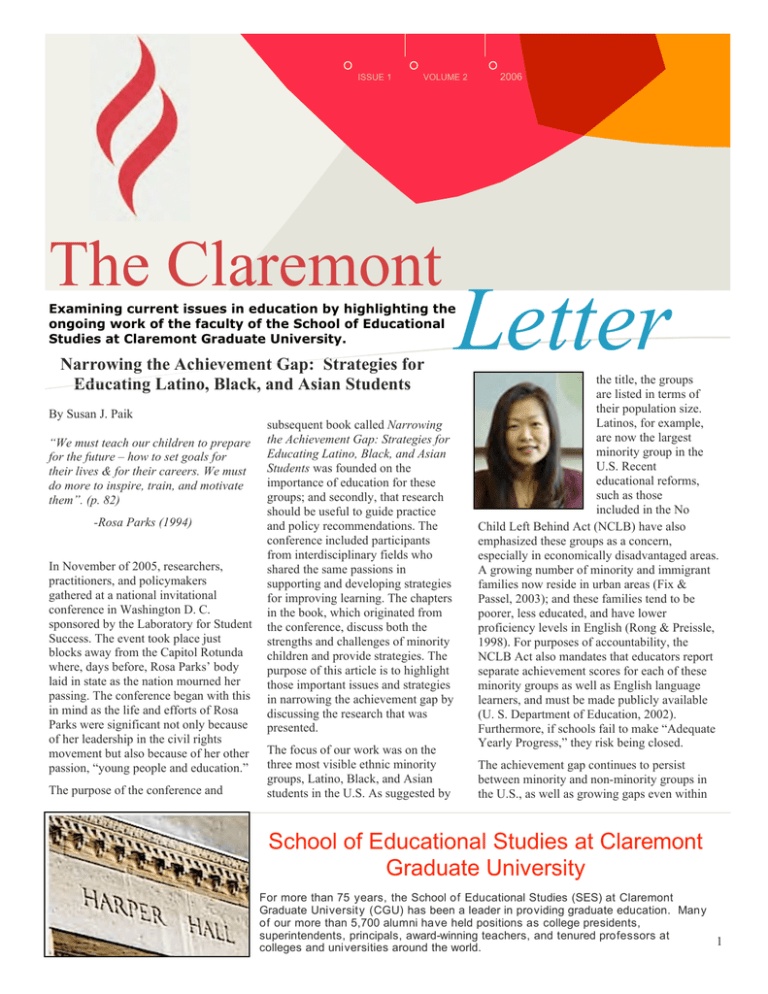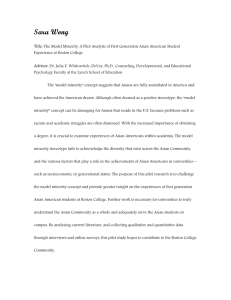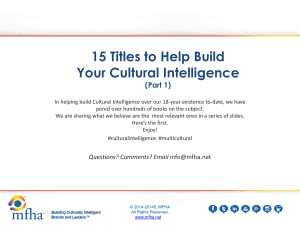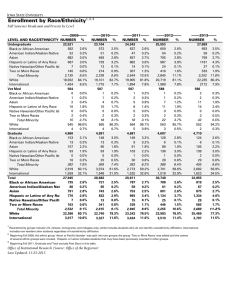Letter The Claremont
advertisement

ISSUE 1 VOLUME 2 The Claremont 2006 Letter Examining current issues in education by highlighting the ongoing work of the faculty of the School of Educational Studies at Claremont Graduate University. Education Narrowing the Achievement Gap: Strategies for Educating Latino, Black, and Asian Students By Susan J. Paik “We must teach our children to prepare for the future – how to set goals for their lives & for their careers. We must do more to inspire, train, and motivate them”. (p. 82) -Rosa Parks (1994) In November of 2005, researchers, practitioners, and policymakers gathered at a national invitational conference in Washington D. C. sponsored by the Laboratory for Student Success. The event took place just blocks away from the Capitol Rotunda where, days before, Rosa Parks’ body laid in state as the nation mourned her passing. The conference began with this in mind as the life and efforts of Rosa Parks were significant not only because of her leadership in the civil rights movement but also because of her other passion, “young people and education.” The purpose of the conference and subsequent book called Narrowing the Achievement Gap: Strategies for Educating Latino, Black, and Asian Students was founded on the importance of education for these groups; and secondly, that research should be useful to guide practice and policy recommendations. The conference included participants from interdisciplinary fields who shared the same passions in supporting and developing strategies for improving learning. The chapters in the book, which originated from the conference, discuss both the strengths and challenges of minority children and provide strategies. The purpose of this article is to highlight those important issues and strategies in narrowing the achievement gap by discussing the research that was presented. The focus of our work was on the three most visible ethnic minority groups, Latino, Black, and Asian students in the U.S. As suggested by the title, the groups are listed in terms of their population size. Latinos, for example, are now the largest minority group in the U.S. Recent educational reforms, such as those included in the No Child Left Behind Act (NCLB) have also emphasized these groups as a concern, especially in economically disadvantaged areas. A growing number of minority and immigrant families now reside in urban areas (Fix & Passel, 2003); and these families tend to be poorer, less educated, and have lower proficiency levels in English (Rong & Preissle, 1998). For purposes of accountability, the NCLB Act also mandates that educators report separate achievement scores for each of these minority groups as well as English language learners, and must be made publicly available (U. S. Department of Education, 2002). Furthermore, if schools fail to make “Adequate Yearly Progress,” they risk being closed. The achievement gap continues to persist between minority and non-minority groups in the U.S., as well as growing gaps even within School of Educational Studies at Claremont Graduate University For more than 75 years, the School of Educational Studies (SES) at Claremont Graduate University (CGU) has been a leader in providing graduate education. Many of our more than 5,700 alumni have held positions as college presidents, superintendents, principals, award-winning teachers, and tenured professors at 1 colleges and universities around the world. minority groups. How can we narrow the achievement gap with the growing number of minority students? Students and families from disadvantaged homes, especially those ethnic minority populations who are rapidly growing in the United States are of particular concern. Latino, Black, and Asian Students: A Growing Population Minority children and youth, particularly immigrant children are the fastest growing population in U.S. schools. It is estimated that the ratio of immigrant children in grades K-12 is one in five, representing 19% of schoolchildren (Fix & Passel, 2003). The foreign-born population is currently over 31.1 million, which is at an all-time high (Fix & Passel, 2003). Currently, 10.5 million students are children of immigrants; roughly one-fourth are foreign-born and three-fourths are U.S. born (Fix and Passel, 2003). The largest immigrant groups seeking education in the U.S. are Latinos, Asians, and Caribbean and African Blacks (Rong & Preissle, 1998). Latinos are currently the largest minority population representing over 13% in the U.S. Asian and Pacific Islander Americans represent over 4% in the U.S. population. Though the Black immigrant population is smaller, U.S. born Blacks are the second largest minority group that constitute over 12 % of the population. In the U.S., many ethnic minority groups, particularly immigrant families tend to be among the poorer income groups. In general, low-income, minority children face additional challenges to succeeding in school, widening the achievement gap throughout the school years. Ongoing research from the Early Childhood Longitudinal Study of the Kindergarten class of 1998-1999 (ECLS-K) demonstrates that achievement gaps between disadvantaged and more advantaged children grew wider over the first four years of school attendance (West, Denton, Germino Hausken, 2000 as cited in Rathbun and West, p. x). While the research on Latino and Black populations is well cited regarding the achievement gap (Rathbun & West, 2004, p. vii-viii), there is also growing concern over Asian populations. Typically, East Asians have done considerably well, but recent research shows that some groups from South or Southeast Asian groups do not perform as highly. More recently, some East Asian groups are also struggling academically (Lew, 2006). As the diverse Asian communities are growing, there is concern to disaggregate the data and understand the needs given the little existing research on Asian American students (Lee, Pang, Zhou, publications in progress in current book). Many students also come from nonEnglish speaking countries (e.g. Asia, Africa, and Latin America). Limited English mastery, economic hardships, and cultural barriers are often obstacles to success in school and life. Many believe without better opportunities, large numbers of foreign-born and U.S. born Latino, Black, and Asian students will continue to be marginalized in the United States. As a result of these trends, practitioners, researchers, and policymakers must work hard to understand, support, and increase the success rates for these students. ENGAGEMENT SOCIAL JUSTICE ACCOUNTABILITY About the Conference and Book: Implications for Policy and Practice Narrowing the Achievement Gap was a way to bring together the experts on the three groups to provide solutions to the problems and discuss the strengths of different communities. The invited authors are top scholars and leaders in the fields of education, psychology, anthropology, sociology, and ethnic studies. Each of the authors brought their own expertise and perspectives to address the issues for their respective groups and was asked to provide clear recommendations. Policymakers and practitioners were also invited to contribute to the discussion. In trying to understand these groups, we found that it was rare to find an array of research expertise on Latino, Black, and Asian children in a single volume. This motivated us to bring together the expertise on the three themes represented in the conference and book. The themes were systematically organized into three panels on culturally diverse families and schooling, issues of immigration and schooling experiences, and teaching and learning issues. Rather than sorting themes by three distinctive groups, this organization allowed us to discuss the similarities and differences among the “The faculty of the school of educational studies believes a socially just nation educates all its diverse citizenry through networks of effective and accountable organizations that interact responsibly with families and communities…” -From our mission statement 2 groups. Research often discusses the differences, but understanding similarities across the groups may provide greater insight into the problems and contexts that affect all minority students. The papers that were presented synthesized research-based findings on the practices in homes, schools, and communities to help increase our understanding of psychological resilience, academic performance, and pro-social behavior. Since classrooms have now changed, it is imperative to understand the background of culturally diverse families and students in order to shape effective schooling experiences. The following summaries from each paper provide policy and practical implications and help illustrate the discussions that took place at the conference. Section One: Culturally Diverse Families and Schooling Fostering Latino Parent Involvement in the Schools: Practices and Partnerships. (Concha Delgado-Gaitan, Ch. 2). Employment statistics reveal a strong correlation between college attainment and well-paying employment opportunities. For Latino students, however, college entrance is often unattainable. The underrepresentation of Latinos prompted Delgado-Gaitan’s questions of what needs to be done, beginning at the elementary school level, to increase Latino student college admission. A 4year ethnographic study involving 20 Latino families from Central America and Mexico, in a Northern California community, traced the socialization of young Latino students and their families preparing for college admission. Delgado-Gaitan discusses the importance of Latino parent involvement, practices in the home and school, and effective partnerships as exemplified in a Mother-Daughter county schools project. Parenting, Social Emotional Development, and School Achievement of African American Youngsters (Ronald D. Taylor, Ch. 3). Renewed attention has been devoted to the gap in the achievement between African American and European American students. On a variety of indicators (e.g., grades, SAT scores, college attendance and completion), African American youngsters fare poorly compared to European American adolescents. The gap in the achievement appears before kindergarten and continues into adulthood. Among the factors linked to differences in achievement have been social class, teacher expectations and perceptions, parental expectations and practices. Ron Taylor discusses family relations, parenting practices and their association with adolescents’ school achievement and social and emotional adjustment. Taylor also discusses factors that impact the functioning of African American families, economic resources and neighborhood conditions, and social networks. Asian Pacific American Cultural Capital: Understanding Diverse Parents and Students. (Valerie Ooka Pang, Ch. 4). Pang’s chapter provides an informed discussion regarding the cultural values that shape the behaviors and achievement of Asian Pacific American (APA) students. Bronfenbrenner’s ecological model of human development is used to explain how families, particularly APA families encourage and reinforce educational achievement. Pang also discusses the experiences, backgrounds, and educational needs of diverse APA groups by providing examples of the various groups (e.g., Cambodian, Chinese, Filipino, Japanese, Korean, Lao, and Vietnamese, etc.). She explains that their educational needs may be similar, but their social and academic experiences may differ due to various elements such as history and generational levels in the U.S. Section Two: Histories, Issues of Immigration, and Schooling Experiences The Mobility/Social Capital Dynamic: Understanding Mexican American Families & Students (Robert K. Ream and Ricardo D. Stanton-Salazar, Ch. 5). Latinos are the largest minority group in the United States, increasing eight times more rapidly than the population as a whole. Their rising numbers come with concern about the status of Latino students in schools. The two-thirds of all U.S. Latinos who are of Mexican descent are challenged with disproportionately high dropout rates and low-test scores. Ream and Stanton-Salazar argue that Mexican American underachievement is partly due to the instability in social relationships that accompanies particularly high rates of transience among them. “Like the frequent repotting of plants”, residential and student mobility disrupts social root systems and the context for interaction. It follows that the mobility/social capital dynamic, whereby mobility impacts the resources inherent in social networks, merits attention on the basis of its sway over relationship stability and academic achievement. Educational Attainment of Immigrant and Non-Immigrant Young Blacks, (Xue Lan Rong and Frank Brown, Ch. 6). As African American experiences move into the 21st century, diverse educational attainment patterns and schooling behaviors have emerged among Black students. Recent immigrant Blacks from the Caribbean and Africa differ from Blacks who have lived in the United States for many generations. To compare and contrast the groups, Rong and Brown first discuss the similarities and differences with respect to immigration experiences and history, family and community environments, and schooling experiences. Rong and Brown then focus the discussion on the variations in educational attainment in African and Caribbean immigrants and non3 Section Three: Socio-cultural Issues on Teaching, Learning, and Development immigrants affected by region or country of origin, generation in the United States, gender, age, and socioeconomic status. Their chapter draws on insights from direct observations and demographic data from the 2000 census. Their chapter also identifies and differentiates causes for variable patterns in educational attainment (e.g. schooling behaviors, self-defined identities). Divergent Origins and Destinies: Children of Asian Immigrants (Min Zhou, Ch. 7). There has been relatively little concern with whether or not children of Asian immigrants can make it into the American mainstream, partly because of their comparatively high socioeconomic status upon arrival and partly because of their extraordinary educational achievement. The general perception is that a great majority of them, even those from poor socioeconomic backgrounds, will succeed in school and life, and that the “model minority” image represents a reality rather than a myth. Zhou examines the problems and limitations of the homogenized image of Asian Americans based on the analysis of the U.S. census data and her own ethnographic case studies in Asian immigrant communities. Zhou argues Asian immigrants and their US-born or raised children are living in a society that is highly stratified not only by class but also by race. This reality, combined with unique cultures, immigration histories, family and community resources, has shaped and, to an important extent, determined the educational outcomes of the children of Asian immigrants. Educational Issues and Effective Practices for Hispanic Students (Hersh C. Waxman, Yolanda N. Padrón, and Andres García, Ch. 8). Waxman, Padron, and Garcia summarize some of the critical educational problems facing Hispanic students and provide some recommendations to alleviate the problems. Their chapter is divided into four major sections. The first section focuses on the educational status of Hispanic students in the United States. The second section discusses factors associated with the underachievement of Hispanic students. This section includes problems associated with the need for qualified teachers, inappropriate teaching practices, and at-risk school environments. The third section examines factors associated with the success of Hispanic students. Waxman, Padron, and Garcia provide a brief summary of programs, schools, and instructional strategies that have been found to significantly improve the academic achievement of Hispanic students. Improving the Schooling Experiences of African American Students: What School Leaders and Teachers Can Do (Gail L. Thompson, Ch. 9). Although there now exist numerous achievement gaps, Thompson informs us that the BlackWhite achievement gap has historically received more attention than the other gaps, primarily because of the attention given to it via the U.S. Supreme Court ruling in Brown versus Board of Education. In spite of this attention, educators have failed to close the gap, and today, as a result of the current unprecedented pressure to improve students’ standardized test scores as a result of NCLB, narrowing the BlackWhite gap has become a top priority at school districts nationwide. Thompson’s chapter presents pertinent research from researchers, and African American parents and students regarding how educators can increase their efficacy with African American students. Thompson begins with a summary of research on the role of school leaders and then presents “Seven things that African American students need from their teachers”. The Truth and Myth of the Model Minority: The Case of Hmong Americans (Stacey J. Lee, Ch. 10). While there are Asian American students who are highly successful, the model minority stereotype hides variation in academic achievement across ethnic groups and among individuals. Lee discusses how disaggregated data on Asian Americans reveals significant differences between East Asian and South Asian groups that have high levels of educational attainment, and Southeast Asians who have relatively low levels of educational attainment. As a primary example, the chapter examines the case of Hmong Americans, a group that has experienced significant barriers to education. Based on data from Lee’s ethnographic study of Hmong American high school students in the Midwest, her chapter discusses economic, racial and cultural barriers that Asian students, Hmong students in particular, face in schools. Her study examines the impact of the model minority stereotype on lower achieving Asian American students. Consensual Recommendations Due to the interdisciplinary perspectives of the book and conference, the consensual recommendations altogether represented a comprehensive, integrated, holistic view. The strategies from the authors and conferees were carefully reviewed and synthesized into the following seven major themes. The list below includes the building blocks, resources, and social capital needed to support minority students: 1) 2) 3) 4) 5) 6) 7) Systemic Change Diversity Awareness Research & Policy Action School Factors Family Involvement Community Support Social Networks Systemic Change. Research consistently tells us that real change must be systemic on all levels—across and within institutions, whether it is in the home, school, community, state, and/or national levels. Practice and policy must go hand in hand as national efforts are important 4 in sustaining local efforts. In addition, we must go beyond the “One size fits all” model in working with the specific needs of minority communities. Diversity Awareness. Given the ethnic composition of our schools, diversity of individuals and communities should be considered more than ever. Consequently, one of the resounding themes and recommendations focuses on the importance of better understanding Latino, Black, and Asian students. Recommendations from this section include diversity awareness in teacher training and professional development, incorporating culturally relevant pedagogy, and developing events that value students’ diverse backgrounds. Research and Policy Action. Researchers, policymakers, and practitioners consistently tell us that good research is needed to understand the alterable factors that promote achievement and well-being on the three groups. Recommendations include disciplined inquiry on all three groups for data-driven implications, and disaggregating data to understand differences even within cultural groups. Collaborative efforts are needed from all stakeholders in order to support minority students. School Factors. Poor minority children often attend poor schools. These communities tend to lack resources and face many challenges. Recent research has shown, however, that some high poverty schools can be high achieving schools. As confirmed by the Center for Public Education (2005), our recommendations included a similar list as provided by the study: 1) A culture of high expectations, 2) A safe and disciplined environment, 3) A principal who is a strong instructional leader, 4) Hard-working, committed, and able teachers, 5) A curriculum focused on academic achievement that emphasizes basic skills in math and literacy (based on local/state standards), 6) Increased instructional time, 7) On-going, diagnostic assessment (built-in accountability systems), 8) Parents as partners in learning, 9) Professional development to improve student achievement, and 10) Collaboration among teachers and staff. Family Involvement. Parent participation and involvement is still largely an untapped resource in the schools, where communication must be fostered and increased from both parties. Although research has consistently reported that parenting practices make a difference for student success, many parents may be too busy or unaware of such practices. Parent participation in the schools may reinforce some of these practices in the home. Recommendations include workshops, events, and programs for parents to collaborate, as well as be informed about their child’s education. Community Support. Community support is critical for families and schools. Further insight into the ethnic community may also provide understanding of minority students. Like parent involvement, community resources are also an untapped resource for many families and schools. Locating and developing important services in communities are particularly important to low SES families. Social Networks. Most important and most relevant to all the factors presented, this recommendation has powerful implications for students as they develop healthy social networks. Research shows that students can benefit greatly from social relationships. The importance of relationships with peers, parents, teachers, counselors, schools, and programs do matter. Recommendations include fostering healthy relationships and providing effective training and knowledge to families and students to know how to utilize resources. As minority populations continue to grow in the U.S., it is important to understand culturally diverse students in order to support their schooling experiences. This article addresses several of these issues and discusses the importance of strategies for schools and families regarding Latino, Black, and Asian students. Collaborative efforts are needed from all stakeholders in order to support minority students. In closing, may we be reminded of Rosa Parks’ life and views of the empowerment of education --- that all children can learn and achieve. Note: Excerpts taken from the book, Narrowing the Achievement Gap: Strategies for Educating Latino, Black, and Asian Students (Paik & Walberg, 2007). More information on the forthcoming book can be found at: www.springer.com. The book will be released early next year by Springer as a 5 volume in the University of Illinois at Chicago Series on Issues in Children’s and Families’ Lives. The book was endorsed by Edmund Gordon, Gloria Ladson-Billings, Luis Moll, and Stanley Sue. Selected References Fix, M. & Passel, J. (2003, January). U.S. Immigration – Trends & Implications for Schools. Paper presented at the meeting of the National Association for Bilingual Education, NCLB Implementation Institute, New Orleans, LA. Center for Public Education. (2005). Research Review: High-performing, High-poverty schools. Retrieved July 20, 2006 from www.centerforpubliceducation.org/site/ Jerald, C.D. (2001). Dispelling the myth revisited: Preliminary findings from a nationwide analysis of “High-flying” schools. Washington, DC: Education Trust. Lew, Jamie. (2006). Asian Americans in Class: Charting the Achievement Gap Among Korean American Youth. New York: Teachers College Press. Parks, Rosa with Gregory Reed. (1994). Quiet Strength: The Faith, the Hope, and the Heart of a Woman who Changed a Nation. Grand Rapids, Michigan: Zondervan Publishing House. Rathbun, A. & West, J. (2004, August) From Kindergarten Through Third Grade: Children’s Beginning School Experiences (NCES 2004–007). U.S. Department of Education, National Center for Education Statistics. Washington, DC: U.S. Government Printing Office, August 2004, see: http://nces.ed.gov/pubsearch/pubsinfo.as p?pubid=2004007 Rong, X. L. & Brown, F. (2002, February). Immigration and Urban Education in the New Millennium: The Diversity and the Challenges. Education and Urban Society, 45 (2), 123-133. Rong, X. L. & Preissle, J. (1998). Educating immigrant students: What we need to know to meet the challenges. California: Corwin Press. Tutwiler, S. W. (1998). Diversity Among Families. In M. L. Fuller and G. Olsen (Eds.). Home –School relations. (pp. 4064). Needham Heights, MA: Allyn & Bacon. U.S. Census. (2004). http://quickfacts.census.gov/qfd/states/0 0000.html U.S. Department of Education (2002). Title 1 – Improving the Academic Achievement of the Disadvantaged. (Public Law 107-110-Jan. 8, 2002). Washington D.C.: Author. Retrieved on May 19, 2003 from the No Child Left Behind website: http://www.ed.gov/legislation/ESEA02/ pg1.html Acknowledgements Special acknowledgements to my coeditor, Herb Walberg, and the Laboratory for Student Success (LSS) for funding and supporting the conference. The LSS operates under a contract with the U.S. Department of Education’s Institute of Education Sciences. We also acknoledge the support of the UIC Series on Issues in Children’s and Families’ Lives. We are deeply grateful to all those involved in this project for their help in supporting the efforts to improve education for minority children and youth. I wish to thank David Drew, John Griesinger, Daryl Smith, Ward Weldon, and the editors of the School of Educational Studies (SES) Letter for their review of this article. Also, special thanks to all my colleagues in the SES at Claremont Graduate University for their continual support for this project. Susan J. Paik is an Associate Professor in the School of Educational Studies at Claremont Graduate University. Dr. Paik co-organized a national conference based on her co-edited book, Narrowing the Achievement Gap: Strategies for Educating Latino, Black, and Asian Students. Her research interests include urban and international studies, educational productivity, culture and learning, family-school collaboration, research methods and evaluation. For her dedication to inner city youth, Dr. Paik received the Early Outreach Award, as well as others, such as the Teaching Incentive Award and Chancellor’s Award. Dr. Paik was also designated as a Young Scholar by the Koret K-12 Task Force at Stanford University. Claremont Graduate University CGU is a member of the Claremont Consortium of seven institutions of higher education (Pomona College, Harvey Mudd College, Claremont McKenna College, Scripps College, Pitzer College, and Keck Graduate Institute). It is an independent institution devoted entirely to graduate education. Claremont Graduate University School of Educational Studies Harper Hall 202 150 East Tenth Street Claremont, CA 91711 Phone (909) 621-8317 Fax (909) 621-8734 E-mail ses@cgu.edu Web http://www.cgu.edu/ses The Claremont Letter is published three times per year in the fall, winter, and spring. I f you would like to subscribe or unsubscribe please send an e-mail to ses@cgu.edu. 6







